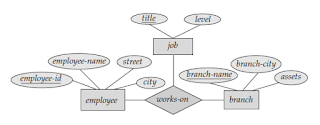Aggregation:
One limitation of the E-R model is that it cannot express relationships among relationships. To illustrate the need for such a construct, consider the ternary relationship works-on in following fig., between an employee, branch, and job.
Fig: E-R diagram for ternary
relationship
Now, suppose we want to record managers for tasks performed
by an employee at a
Branch i.e. we want to record managers for (employee, branch,
job) combinations. Let us assume that there is an entity set manager. One
alternative for representing this relationship is to create a quaternary
relationship manages between employee,
branch, job, and manager.
A quaternary relationship is required in this case because
binary relationship between manager and employee would not permit us to
represent which (branch, job) combinations of an employee are managed by which manager.
Using the basic E-R modeling constructs, we obtain the following E-R diagram:
Fig: E-R diagram with redundant
relationship
But, there is redundant
information in the above fig. since every employee, branch, job combination
in manages is also in works-on. The best way to model a situation such as the
one just described is to use aggregation.
Aggregation is an
abstraction through which relationships are treated as higher level entities. Thus, for our example, we regard
the relationship set works-on (relating the entity sets employee, branch, and
job) as a higher-level entity set called works-on. Such an entity set is
treated in the same manner as is any other entity set. We can then create a binary relationship ‘manages’ between works-on and manager
to represent who manages what tasks as shown in following fig.
Fig: E-R diagram with aggregation.



No comments:
Post a Comment